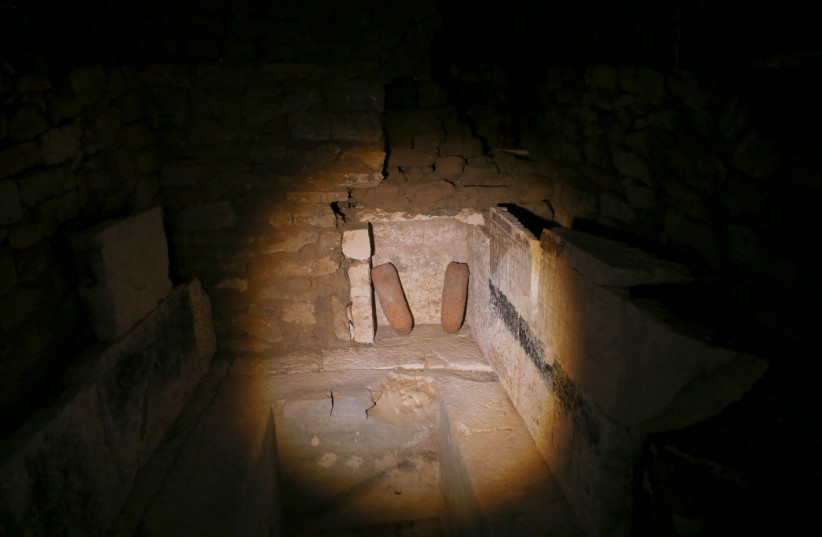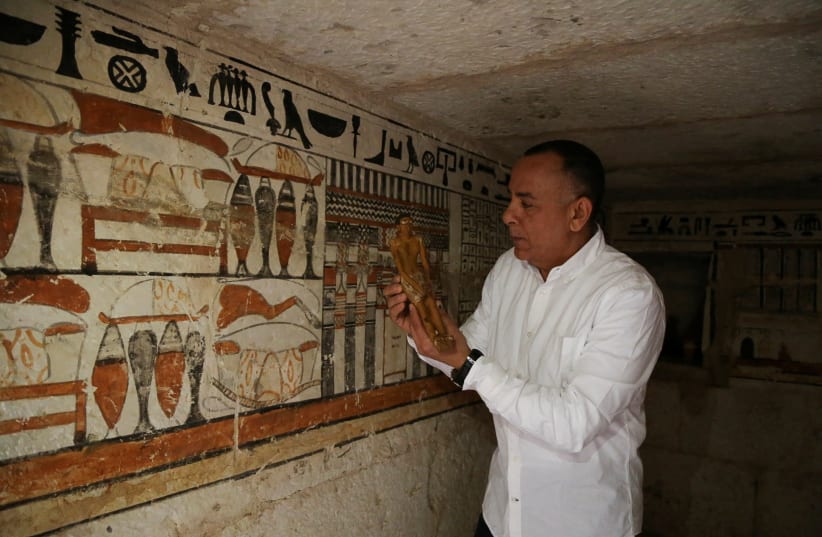Egyptian archaeologists have discovered five ancient painted tombs at a cemetery in Saqqara, outside of Cairo.
The archeologists started excavating at the site 100 meters northwest of the Merenre I Pyramid last September, Supreme Council of Antiquities Secretary-General Mostafa Waziry said. The tombs date back 4,000 years to the Old Kingdom and First Intermediate period and belong to senior officials and regional rulers, the Egyptian Ministry of Tourism and Antiquities said.
Known as the Age of the Pyramids, the Old Kingdom period spanned from 2700 BCE to around 2200 BCE, while the First Intermediate Period, described as a Dark Period, lasted for about 125 years from 2181 BCE to 2055 BCE, after the fall of the Old Kingdom.
Video footage on the ministry’s social-media pages showed Waziry recently being accompanied to the excavation by Tourism and Antiquities Minister Khaled El-Enany to officially present the tombs buried beneath the desert sand. They descended down burial shafts to the well-preserved tombs, whose walls were stunningly covered with Egyptian hieroglyphic inscriptions and still-colorful painted images of sacred animals and afterlife items.
Large wooden and stone coffins and other artifacts, including small statues of people and pottery, were discovered inside the tombs.


Waziry said they believe there are more tombs in the area and that excavations will continue.
According to the English-language Egypt Today, the first tomb belongs to an official with the ancient Egyptian rank of Iry, held by those in a high position of the hierarchy of the country, and houses a limestone sarcophagus. The tomb also contains a deep burial shaft leading to a room decorated with funerary scenes depicting offering tables, the seven sacred oils and a facade of the palace.
The second tomb houses a rectangular burial shaft and belongs to a woman who is most probably the wife of a man named Yaret. The third tomb has a six-meter-deep burial shaft and belongs to a supervisor and priest named Pepi Bethany.
The fourth tomb also has a six-meter-deep burial shaft and belongs to a woman named Petty, who was responsible for the king’s beautification, and also the priest of Hathor.
The final tomb, with a seven-meter-deep rectangular burial shaft, was for a man named Henu, the overseer and supervisor of the royal house.
Saqqara is a part of a sprawling necropolis, or large ancient cemetery for the ancient Egyptian capital of Memphis, which includes the Giza pyramids.
With Egypt’s vital tourism industry hard hit in recent years, first by the political turmoil following the outbreak of the Arab Spring in 2011 and then by the COVID-19 pandemic in 2019, the country had hoped for better days. But then Russia’s invasion of Ukraine – both a major source for tourism – once again dashed hopes for a smooth recovery.
Eager to garner publicity and attract tourists, the Ministry of Tourism and Antiquities invited Egyptian bloggers, influencers and journalists to view the Saqqara tombs.
